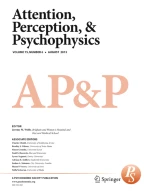Abstract
The aim of this study was to measure the perceptual attenuation, measured in decibels, resulting from the focusing of attention on one stream within a multistream auditory sequence. The intensity of a nonfocused stream was increased until the accuracy of detecting a temporal irregularity in this stream was the same as in a focused stream. Eight subjects were required to detect a temporal irregularity created by delaying or advancing one tone which could be situated in one of three temporally regular streams played simultaneously to create a multistream sequence. The three streams differed in tempo and frequency. Subjects’ attention was focused on one of the streams by preceding the multistream sequence with one of the single streams (a cue). We first established the size of temporal irregularity detected at a 90% level in cued streams, confirming that subjects were able to focus on one particular stream. Second, an irregularity of this size was not detected above chance level in noncued streams, demonstrating that listeners focus only on the cued stream. Third, for 5 subjects, a 15-dB increase in the level of one of the noncued streams was necessary to bring detection up to that found in the cued streams. This gain provides an equivalent measure of the perceptual attenuation of nonfocused streams. For 3 other subjects, detection in the noncued stream remained at chance performance whatever the level. For all subjects, detection in the cued stream decreased slightly as the level of the noncued stream increased. We conclude that the attenuation of nonfocused auditory streams can attain as much as 15 dB, at least for some subjects.
Article PDF
Similar content being viewed by others
Avoid common mistakes on your manuscript.
References
Bregman, A. S. (1990).Auditory scene analysis. The perceptual organization of sound. Cambridge, MA: MIT Press.
Brochard, R., Drake, C., Botte, M. C., &McAdams, S. (1995). Focusing attention on one auditory stream does not depend on the number of simultaneous streams.Fechner Day ’95: Proceedings of the Eleventh International Conference of Psychophysics (pp. 155–160). Marseille: Camille-Aimé Possamaï.
Dai, H., Scharf, B., &Buus, S. (1991). Effective attenuation of signals in noise under focused attention.Journal of the Acoustical Society of America,89, 2837–2842.
Dowling, W. J., Lung, K. M.-T., &Herrbold, S. (1987). Aiming attention in pitch and time in the perception of interleaved melodies.Perception & Psychophysics,41, 642–656.
Greenberg, G. Z., &Larkin, W. D. (1968). Frequency-response characteristic of auditory observers detecting signals of a single frequency in noise: The probe-signal method.Journal of the Acoustical Society of America,44, 1513–1523.
Halpern, A. R., &Darwin, C. J. (1982). Duration discrimination in a series of rhythmic events.Perception & Psychophysics,31, 86–89.
Hirsh, I. J., Monahan, C. B., Grant, K. W., &Singh, P. G. (1990). Studies in auditory timing: 1. Simple patterns.Perception & Psychophysics,47, 215–226.
Jones, M. R. (1976). Time, our lost dimension: Toward a new theory of perception, attention, and memory.Psychological Review,83, 323–355.
Leiss-Rossio, B. (1986).Temporal specificity: Signal detection as a function of temporal position. Unpublished doctoral dissertation, University of Iowa.
Levitt, H. (1971). Transformed up-down methods in psychoacoustics.Journal of the Acoustical Society of America,49, 467–477.
Luce, R. D., Green, D. M., &Weber, D. L. (1976). Attention bands in absolute identification.Perception & Psychophysics,20, 49–54.
McAdams, S. (1984). The auditory image: A metaphor for musical and psychological research on auditory organization. In W. P. Crozier & A. J. Chapman (Eds.),Cognitive processes in the perception of art (pp. 289–323). Amsterdam: North-Holland.
Monahan, C. B., &Hirsh, I. J. (1990). Studies in auditory timing: 2. Rhythm patterns.Perception & Psychophysics,47, 227–242.
Mondor, T. A., &Bregman, A. S. (1994). Allocating attention to frequency regions.Perception & Psychophysics,56, 268–276.
Scharf, B., Possamaï, C. A., &Bonnel, A. M. (1989). Detective psychophysics: The probe signal method and focused attention. In S. Dornis & G. Gunggren (Eds.),Psychophysics in action 1989 (pp. 67–80). Berlin: Springer-Verlag.
Schlauch, R. S., &Hafter, E. R. (1991). Listening bandwidths and frequency uncertainty in pure-tone signal detection.Journal of the Acoustical Society of America,90, 1332–1339.
Treisman, A. M. (1969). Strategies and models of selective attention.Psychological Review,76, 282–299.
van Noorden, L. P. A. S. (1975).Temporal coherence in the perception of tone sequences. Unpublished doctoral dissertation, Technical University of Eindhoven, The Netherlands.
Wright, B. A., &Dai, H. (1993). Detection of unexpected tones in noise: The effect of signal duration.Journal of the Acoustical Society of America,93, 2366–2367.
Author information
Authors and Affiliations
Corresponding author
Additional information
This paper was written after the untimely death of Marie-Claire Botte. Her absence during the final stages of this research was greatly regretted by her coauthors. The research was supported in part by a grant from the French Ministry of the Environment. Part of these data were presented at the 127th Meeting of the Acoustical Society of America, Cambridge, MA, in June 1994.
Rights and permissions
About this article
Cite this article
Botte, MC., Drake, C., Brochard, R. et al. Perceptual attenuation of nonfocused auditory streams. Perception & Psychophysics 59, 419–425 (1997). https://doi.org/10.3758/BF03211908
Received:
Accepted:
Issue Date:
DOI: https://doi.org/10.3758/BF03211908
